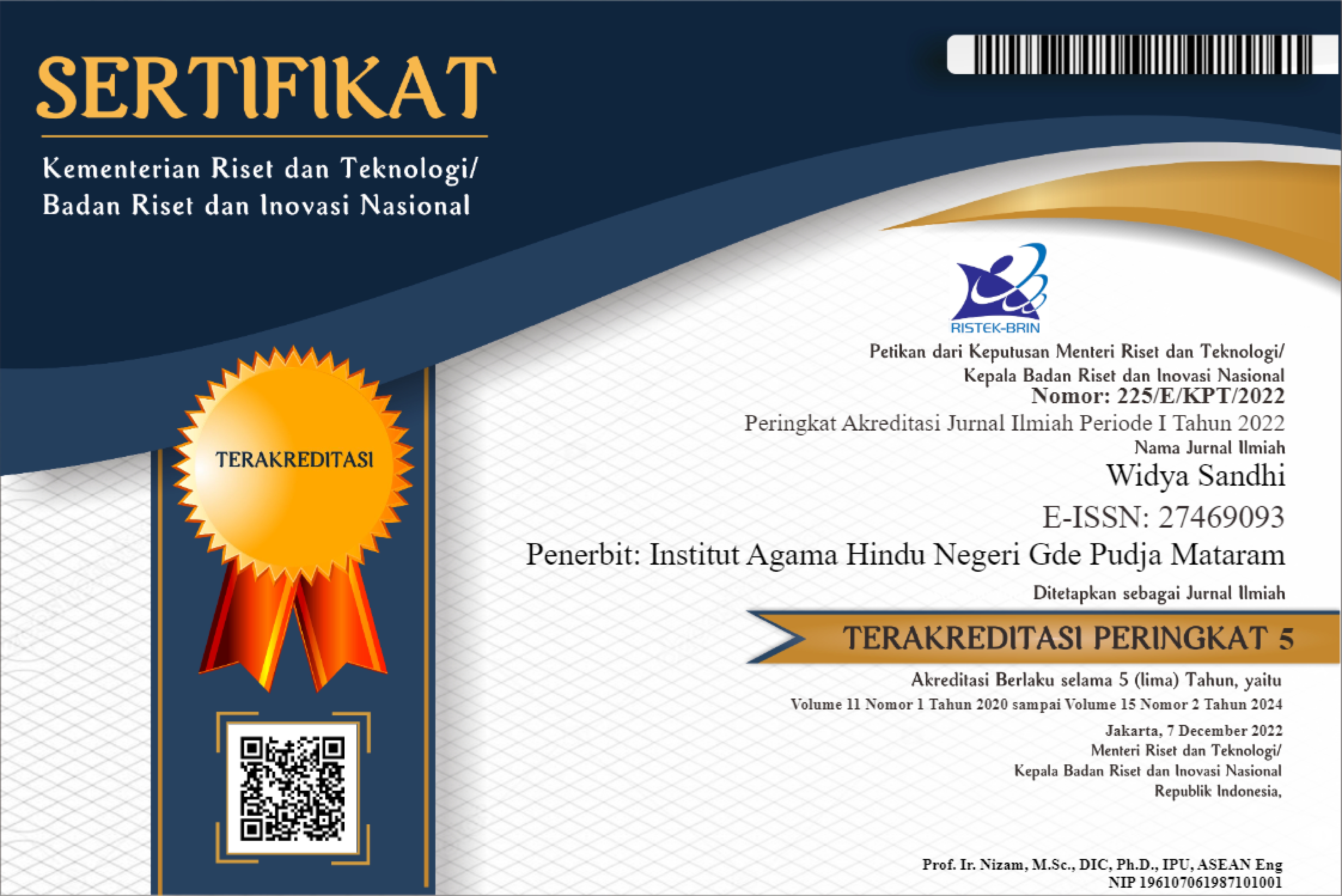IMPLEMENTASI TRADISI BAADAT PADA RITUAL KEMATIAN MASYARAKAT HINDU KAHARINGAN DI KABUPATEN LAMANDAU
Abstract
Culture is the whole complex which includes knowledge and belief, art, morals, law, customs, and habits acquired by humans as members of society. The Hindu Kaharingan community in Lamandau Regency has various kinds of religious rituals, including birth, marriage, and death. One thing that is very unique and there is a phenomenon to be studied in this research is that there is a tradition in the ritual of death called the Baadat tradition which is a tradition that can only be done by one family group who is Hindu Kaharingan only, and Baadat is only done when a family member died. This tradition is very unique in that it is a cultural hasanah or heritage from our ancestors which has a very high philosophical meaning when compared to other religious ritual traditions. Therefore, traditions like this must be preserved and maintained in their integrity even though they face various challenges and obstacles as a result of the impact of the influence on the entry of modern cultures that can change from the actual cultural order, especially in the Baadat tradition of death rituals.
References
Bakker. 1984. Filsafat Kebudayaan Sebuah Pengantar. Yogyakarta : Kanisius.
Bappeda Lamandau. (2021). SEJARAH KABUPATEN LAMANDAU. http://bappeda.lamandaukab.go.id/sejarah-kabupaten-lamandau/
Budiati, A. C. (2009). Sosiologi Kontekstual Untuk SMA & MA. Pusat Perbukuan Departemen Pendidikan Nasional.
Connoli, Peter. 2002. Aneka Pendekatan Studi Agama. Yogyakarta LKiS.
Daeng, Hans. J. 2005. Manusia, Kebudayaan dan Lingkungan Tinjauan Antropologis. Yogyakarta : Pustaka Pelajar Offset.
Devi, A. (2019). solidaritas sosial dalam peristiwa kematian pada masyarakat dusun ngulu tengah,desa pracimantoro, kecamatan pracimantoro, kabupaten wonogiri. Pendidikan Sosiologi Antropologi FKIP UNS.
Geertz, Clifford. 2001. “Agama sebagai Sistem Kebudayaan” . Dalam buku Dekonstruksi Kebenaran Kritik Tujuh Agama. Terjemahan Inyiak Ridwan Muzir, M. Syukri. Yogyakarta: IRCiSoD.
Kaelan. 2005. Metode Penelitian Kualitatif Bidang Filsafat. paradigma : Yogyakarta.
Kamajaya. (2001). Alam Kehidupan Sesudah Mati. PARAMITA.
Karmini, N. W. (2002). Agama Hindu Untuk SMU. Ganeca.
¬¬¬Koentjaranigrat. 1987. Sejarah Teori Antropologi. Jakarta : Universitas Indonesia
Kolip Usman dkk. 2011. Pengantar Sosiologi Pemahaman Fakta Dan Gejala Permasalahan Sosial : Teori Aplikasi Dan Pemecahan. Jakarta : Kencana
Moleong,lexy J. 2004. Metodologi Penelitian Kualitatif, Remaja Rosdakarya : Bandung.
Riwut, Tjilik .2003. Maneser Panatau Tatu Hiang, Menyelami Kekayaan Leluhur, Pusaka Lima : Palangka Raya.
Suprayoga dan Tambroni. 2001. Metodologi Penelitian Sosial Agama, Remaja Rosdakarya : Bandung.
Subagyo, Joko. 2004. Metode Penelitian Dalam Teori Dan Praktek. Rineka Cipta: Jakarta.
Surayin, Ida Ayu Putu, 2004. Dewa Yadnya, Surabaya : Paramitha
Sztompka, Piotr. 2010. Sosiologi Perubahan Sosial. Jakarta : Prenada
Tim Penyusun. 2002. Panaturan. Majelis Besar Agama Hindu Kaharingan : Palangka Raya.
Tim Penyusun. 1991. Kamus Besar Bahasa Indonesia. Jakarta : Balai Pustaka.
Triguna,Ida Bagus Gede Yudha. 2004. Teori tentang Simbol. Denpasar : Widya Dharma.

This work is licensed under a Creative Commons Attribution-NonCommercial-ShareAlike 4.0 International License.
Authors who publish with this journal agree to the following terms:
- Authors retain copyright and grant the journal right of first publication with the work simultaneously licensed under a Creative Commons Attribution-ShareAlike 4.0 International License. that allows others to share the work with an acknowledgment of the work's authorship and initial publication in this journal.
- Authors are able to enter into separate, additional contractual arrangements for the non-exclusive distribution of the journal's published version of the work (e.g., post it to an institutional repository or publish it in a book), with an acknowledgment of its initial publication in this journal.
- Authors are permitted and encouraged to post their work online (e.g., in institutional repositories or on their website) prior to and during the submission process, as it can lead to productive exchanges, as well as earlier and greater citation of published work (See The Effect of Open Access).






.jpg)




